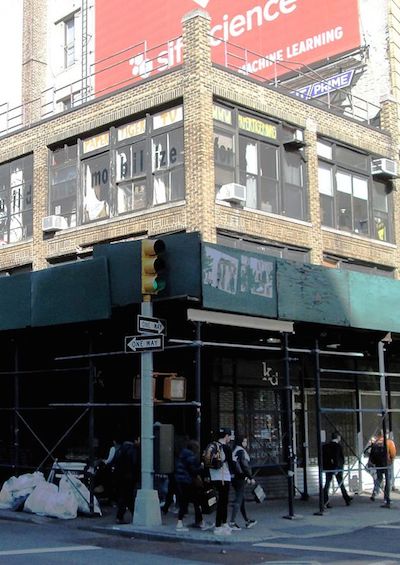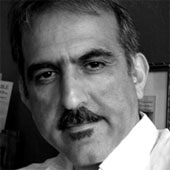A Love Letter to 339 Lafayette: NYC Then and Now
Memories of student activism in a changing New York neighborhood.
May 7, 2016

A three-story building on the corner of Lafayette Street and Bleaker Avenue – nicknamed the “Peace Pentagon” – helped shape the person I am now.
A few days ago a friend sent me link to a New York Times article about the purchase of 339 Lafayette Street by a real estate developer for $20.75 million. (The building had structural issues too costly for the non-profit ownership to repair.)
As I read the article, I remembered the day in fall 1978 when I pressed the buzzer for a third floor office in 339 Lafayette Street the very first time.
I had arrived in New York a couple months earlier to start my graduate studies at Fordham University. After two years in Oklahoma and Texas, I was so excited to be in New York City. My heart was, however, somewhere else. I could not stop thinking about Iran.
Iran was engulfed in a popular revolution. Men and women, and young and old were protesting against the Shah, Iran’s dictator. They were demanding change. They wanted a new life with normal freedoms others enjoyed elsewhere in the world. By mid fall of 1978, the government of the Shah was quickly losing ground.
Like most young Iranians studying in the United States, I was drawn to the revolutionary fervor against the Shah. One day, a friend invited me to a Friday meeting by Iranian students in downtown Manhattan. I accepted the invitation.
Home away from home
That Friday evening, for the first time, I walked up the narrow stairways in 339 Lafayette Street to the office of the Iranian Student Association on the third floor. I continued to do the same every Friday for more than 10 years.
The Shah was removed from power in February 1979. But we continued to meet every Friday. The new government, The Islamic Republic of Iran, made many promises to improve people’s lives and bring freedom to the Iranian people.
But soon the new rulers proved to be even more repressive and brutal than the Shah. We had gone from bad to worse. We could not stop meeting and protesting.
I kept returning to 339 Lafayette every Friday. The three-story building became my second university. It nourished me intellectually and gave me a chance to share ideas with like-minded people, learn about the world, and become a part of the movement for democratic rights and peace.
I learned to love people more than things, share what I had with others, and spend much of my time to make the world a better place for all.
We were 20 or so young men and women. At times, we had uninvited guests from the neighborhood. A family of mice would show up in the middle of our meetings. They would parade by the walls, and sometimes drift in different directions underneath our feet.
All of a sudden, 40 or so feet would be lifted from the metal folding chairs. There would be giggles and sighs of panic. And the mice would mind their business, paying no attention to our heated conversations about democracy, and war and peace.
A changing neighborhood
A collective of young pro-democracy Nicaraguans, and another Iranian student group had offices on the third floor. The Socialist Party USA, and the War Resisters League were on the second floor.
I remember occasionally running into David McReynolds, the President of the Socialist Party USA in 339 Lafayette Street. In 1980, McReynolds ran for President of the United States. McReynolds smiled anytime we greeted each other in the stairways.
Our office was straight above the War Resisters League, which was above a corner coffee shop owned and operated by a Spanish couple. Coffee was 50 cents. The homemade bean soup was less than a dollar.
We had rented the office space at $100 a month. Our rent never changed. The neighborhood did. As if it was hit by a massive storm, the neighborhood was turned upside down in less than 10 years. And somehow, 339 Lafayette Street survived the storm.
By the end of the 1980s, nothing around us looked the same. The coffee shop closed. It was replaced by a store selling chic leather handbags. The kind Spanish owner was no more.
Stylish young white women sold handbags instead. The handbag store never did much business. Soon it was replaced by a boutique selling funky designer clothes. Meanwhile more changes arrived everywhere around us.
Old and affordable restaurants shut down. New fancy restaurants opened up. They too shut down, giving room to fancier and more expensive businesses. Condominiums replaced tenements. Old buildings were demolished. Expensive high-rises replaced them.
Farewell, 339 Lafayette Street
By the late 1980s, the Iranian Student Association and other student groups closed their offices. I finally managed to graduate, after years of neglecting my studies. So did the other Iranian students meeting on Fridays in 339 Lafayette Street.
I became a college professor. Others worked as architects, doctors, and engineers. We moved on. But most of us retained what we learned during those great years in 339 Lafayette Street. The building and all that it represented had become an organic part of our lives. 339 Lafayette Street shaped who we were.
Soon, the three-story building on 339 Lafayette will be bulldozed to the ground. Its rubble will be trucked out of the neighborhood and dumped somewhere far away.
A new luxury development will be erected in its place. The passers-by would not know what that address and that corner meant to many of us who spent the formative years of our intellectual lives in 339 Lafayette Street.
Goodbye, dear 339 Lafayette Street!
Takeaways
339 Lafayette St: Memories of student activism in a changing New York neighborhood.
Every Friday for 10 years, I walked up the stairs of 339 Lafayette St to the Iranian Student Association.
A 3-story building on the corner of Lafayette & Bleaker – the “Peace Pentagon” – helped shape who I am.
